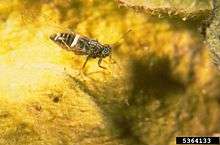''Candidatus'' Liberibacter
| Candidatus Liberibacter | |
|---|---|
 | |
| The potato psyllid, Bactericera cockerelli, feeds on a potato and infects it with Candidatus Liberibacter solanacearum, the bacterium that causes zebra chip disease. | |
| Scientific classification | |
| Kingdom: | Bacteria |
| Phylum: | Proteobacteria |
| Class: | Alphaproteobacteria |
| Order: | Rhizobiales |
| Family: | Rhizobiaceae |
| Genus: | Candidatus Liberibacter |
| Species | |
|
See text | |
Candidatus Liberibacter is a genus of Gram-negative bacteria in the Rhizobiaceae family. The term Candidatus indicates that it has not proved possible to maintain this bacterium in culture. Detection of the liberibacters is based on PCR amplification of their 16S rRNA gene with specific primers. Members of the genus are plant pathogens mostly transmitted by psyllids. The genus was originally spelled Liberobacter.[1]
Species
Named species include:[2]
- Liberibacter africanus originated in Africa and is a causal agent of citrus greening disease, also known as huanglongbing, and vectored by the African citrus psyllid Trioza erytreae.[3]
- Liberibacter americanus is a novel species from Brazil described in 2005 and associated with huanglongbing and vectored by the Asian citrus psyllid Diaphorina citri.[4]
- Liberibacter asiaticus originated in Asia and is a causal agent of huanglongbing, vectored by the Asian citrus psyllid D. citri.[5]
- Liberibacter crescens[6] was isolated from papaya growing in Puerto Rico.
- Liberibacter europaeus is a novel species described in 2010, found in pear trees, where it seems to cause no symptoms and is vectored by the psyllid, Cacopsylla pyri.[7]
- Liberibacter psyllaurous is a novel species described in 2008 from solanaceous host plants potato and tomato and vectored by the potato tomato psyllid Bactericera cockerelli.[8] L. psyllaurous plays a dual role as a plant pathogen and as an inherited bacterial endosymbiont. This symbiont modifies tomato defenses in favor of itself and its psyllid vector.[9]
- Liberibacter solanacearum[10] is a causal agent of zebra chip disease in potatoes and vectored by the potato tomato psyllid Bactericera cockerelli.[11] There are five haplotypes described within this species, designated LsoA and LsoB (from solanaceous plants in North America), and LsoC, LsoD, and LsoE (from carrots and celery in Europe).[12][13] L. psyllaurous is a synonym for L. solanacearum haplotype A[14] (identical 16S rRNA genes).
- Liberibacter brunswickensis[15] associated with the psyllid Acizzia solanicola on eggplant in Australia.
References
- ↑ Taxonomy browser
- ↑ UniProt Consortium
- ↑ EPPO Archived 2010-07-13 at the Wayback Machine.
- ↑ ‘Candidatus Liberibacter americanus’, associated with citrus huanglongbing (greening disease) in São Paulo State, Brazil
- ↑ Featured Creatures
- ↑ Complete genome sequence of Liberibacter crescens BT-1
- ↑ Raddadi, N; Gonella, E; Camerota, C; Pizzinat, A; Tedeschi, R; Crotti, E; Mandrioli, M; Bianco, PA; Daffonchio, D; Alma, A (2011). "'Candidatus Liberibacter europaeus' sp. nov. that is associated with and transmitted by the psyllid Cacopsylla pyri apparently behaves as an endophyte rather than a pathogen". Environ. Microbiol. 13 (2): 414–26. doi:10.1111/j.1462-2920.2010.02347.x. hdl:2318/133454. PMID 21040355.
- ↑ A New Huanglongbing Species, "Candidatus Liberibacter psyllaurous", Found To Infect Tomato and Potato, Is Vectored by the Psyllid Bactericera cockerelli (Sulc){triangledown}
- ↑ Manipulation of Plant Defense Responses by the Tomato Psyllid (Bactericerca cockerelli) and Its Associated Endosymbiont Candidatus Liberibacter Psyllaurous
- ↑ "Candidatus Liberibacter solanacearum", associated with plants in the family Solanaceae
- ↑ Evidence that the Zebra Chip Disease and the Putative Causal Agent Can be Maintained in Potatoes by Grafting and In Vitro
- ↑ Nelson, Warrick R; Sengoda, Venkatesan G; Alfaro-Fernandez, Ana O; Font, Maria I; Crosslin, James M; Munyaneza, Joseph E (2012). "A new haplotype of "Candidatus Liberibacter solanacearum" identified in the Mediterranean region". European Journal of Plant Pathology. 135 (4): 633–639. doi:10.1007/s10658-012-0121-3.
- ↑ Teresani, Gabriela R; Bertolini, Edson; Alfaro-Fernández, Ana; Martínez, Carmen; Tanaka, Francisco André Ossamu; Kitajima, Elliot W; Roselló, Montserrat; Sanjuán, Susana; Ferrándiz, Juan Carlos; López, María M; Cambra, Mariano; Font, María Isabel (2014). "Association of "Candidatus Liberibacter solanacearum" with a vegetative disorder of celery in Spain and development of a real-time PCR method for its detection". Phytopathology. 104 (8): 804–11. doi:10.1094/PHYTO-07-13-0182-R. PMID 24502203.
- ↑ Nelson, Warrick R; Fisher, Tonja W; Munyaneza, Joseph E (2011). "Haplotypes of "Candidatus Liberibacter solanacearum" suggest long-standing separation". European Journal of Plant Pathology. 130: 5–12. doi:10.1007/s10658-010-9737-3.
- ↑ Morris, Jacqueline; Shiller, Jason; Mann, Rachel; Smith, Grant; Yen, Alan; Rodoni, Brendan (2017-07-01). "Novel 'Candidatus Liberibacter' species identified in the Australian eggplant psyllid, Acizzia solanicola". Microbial Biotechnology. 10 (4): 833–844. doi:10.1111/1751-7915.12707. ISSN 1751-7915. PMC 5481521. PMID 28387006.
This article is issued from
Wikipedia.
The text is licensed under Creative Commons - Attribution - Sharealike.
Additional terms may apply for the media files.